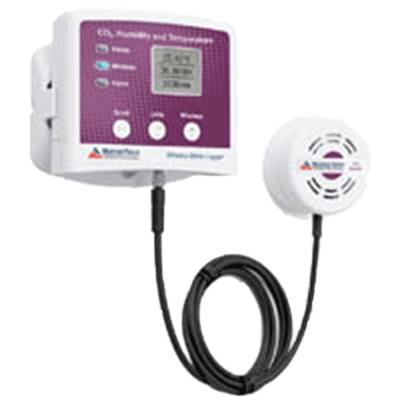What Is a Temperature and Humidity Logger?

A temperature and humidity data logger is a device that automatically measures the temperature and humidity of an installation location and continuously records them at regular intervals.
The measurement interval can be changed arbitrarily, and they are used to guarantee the transportation environment, predict the risk of mold and bacteria by monitoring the temperature and humidity in freezers and refrigerators, and determine the comfort of the workforce.
Uses of Temperature and Humidity Loggers
Temperature and humidity loggers are widely used in any location where temperature and humidity control must be guaranteed. Major applications include the following locations:
- Food storage cases in supermarkets and convenience stores
- Freezer cases
- Food production environments
- Refrigerators and freezers
- Pharmaceutical reference products
- Warehouses
- Cold transport cargo
- Computer rooms
- Laboratories and research laboratories
- Trucks, ships, containers
- Wine cellars
- Museums
Principle of Temperature and Humidity Data Loggers
The temperature and humidity data logger consists of a temperature and humidity sensor and a memory and battery for data storage.
1. Temperature Sensor
The temperature sensor is a thermistor, also known as an NTC thermistor. As the temperature rises, the resistance decreases as current flows through it easily. Thus, changes in temperature change electrical resistance, and this property is used to measure temperature.
2. Humidity Sensor
Humidity sensors are classified into two types: electrical resistance type and capacitance type. Both the electrical resistance and capacitance types have a structure in which a moisture-sensitive material that absorbs and dehumidifies moisture is sandwiched between electrodes, and the method differs depending on whether moisture is measured as electrical resistance or capacitance.
The capacitance type is the mainstream, and can measure humidity even at 20% or lower, and has the advantage of fast response time. The electric resistance type is resistant to noise, and the sensor part can be made smaller.
How to Select a Temperature and Humidity Logger
There are various models of temperature and humidity loggers, and it is important to choose the right one according to whether it has a display, sensor type, data extraction method, and operating environment. The main points to consider when selecting a logger are as follows
1. With or Without Display or Buttons
No Display or Buttons
This type of sensor specializes in storing temperature and humidity data. All operations are performed through the computer. Since there are no buttons on the main unit, there is a small risk of data deletion by inexperienced personnel.
With Display and Buttons
This type allows the user to visually check the measured data. This provides peace of mind because you can check whether the system is working properly. Also, since the start and pause of measurement can be done at hand, temperature and humidity are not recorded in vain from the measurement point to the place where the data is retrieved.
2. Sensor Type
Sensor Integrated Type
The sensor is attached to the main unit. Since there are no cables, the risk of wire breakage is low and the sensor is not easily broken.
Cable Sensor Type
The sensor can be extended from the main unit, so it can be inserted into a narrow space. This type is used to measure temperature and humidity in places where the main unit cannot be placed due to high temperature and humidity, or in confined spaces.
3. Data Extraction Method
Constant Communication Type
This type can constantly manage data using wireless LAN or Bluetooth. This type is useful in places where temperature monitoring is required.
Extraction Type
Data is collected for a certain period of time and then extracted, which is used when strict data assurance is required, such as in FDA, GMP, HACCP, and ISO9001 quality management systems. Data extraction is not limited to PCs; devices that can be used with smartphones and tablets are also available.
4. Usage Environment
High-Precision Type
These temperature and humidity loggers are designed for use in harsh environments. This type of temperature and humidity logger is covered with stainless steel and can measure high temperatures.
Waterproof Type
This type is used outdoors. They do not malfunction even if it rains and can be used with peace of mind.
Calibration Type
Periodic configuration is required for measurements compliant with various plans such as GMP, HACCP, and ISO. The manufacturer can undertake calibration, but the manufacturer’s calibrated product may be used as a secondary standard.
Other Information on Temperature and Humidity Loggers
Relationship Between Temperature and Humidity
Temperature and humidity are usually closely related. The lower the temperature, the less water vapor can be contained in the air; conversely, the higher the temperature, the more water vapor can be contained. This allows us to determine the risk of condensation and the risk of mold growth.
It also affects human senses, such as feeling comfortable if the humidity is low even if the temperature is high. For this reason, temperature and humidity loggers are used for a variety of purposes, including occupational health and comfort management in stores.